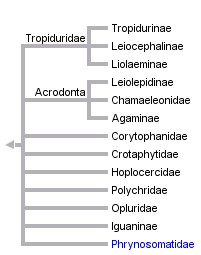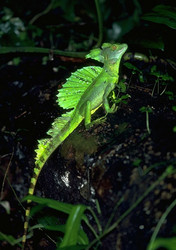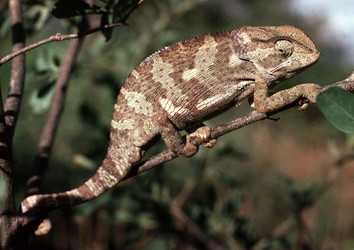Iguania
Kevin de Queiroz and Emilia P. Martins


This tree diagram shows the relationships between several groups of organisms.
The root of the current tree connects the organisms featured in this tree to their containing group and the rest of the Tree of Life. The basal branching point in the tree represents the ancestor of the other groups in the tree. This ancestor diversified over time into several descendent subgroups, which are represented as internal nodes and terminal taxa to the right.

You can click on the root to travel down the Tree of Life all the way to the root of all Life, and you can click on the names of descendent subgroups to travel up the Tree of Life all the way to individual species.
For more information on ToL tree formatting, please see Interpreting the Tree or Classification. To learn more about phylogenetic trees, please visit our Phylogenetic Biology pages.
close boxReferences
Estes, R., K. de Queiroz, and J. Gauthier. 1988. Phylogenetic relationships within Squamata. Pages 119-281 in R. Estes and G. Pregill, eds., Phylogenetic relationships of the lizard families. Essays commemorating Charles L. Camp, Stanford University Press, Stanford, California.
Etheridge, R. 1964. The skeletal morphology and systematic relationships of sceloporine lizards. Copeia 1964:610-631.
Etheridge, R. 1965. The abdominal skeleton of lizards in the family Iguanidae. Herpetologica 21:161-168.
Etheridge, R. 1967. Lizard caudal vertebrae. Copeia 1967:699-721.
Etheridge, R., and K. de Queiroz. 1988. A phylogeny of Iguanidae. Pages 283-367 in R. Estes and G. Pregill, eds., Phylogenetic relationships of the lizard families. Essays commemorating Charles L. Camp, Stanford University Press, Stanford.
Frost, D.R. and R. Etheridge. 1989. A phylogenetic analysis and taxonomy of Iguanian lizards (Reptilia: Squamata). University of Kansas, Museum of Natural History Miscellaneous Publications, No. 81, pp. 1-65.
Miles, D.B., and A.E. Dunham. 1992. Comparative analyses of phylogenetic effects in the life-history patterns of iguanid reptiles. Am. Nat. 139:848-869.
Paull, D., E.E. Williams, and W.P. Hall. 1976. Lizard karyotypes from the Galapagos Islands: Chromosomes in phylogeny and evolution. Breviora (441):1-31.
Savage, J.M. 1958. The iguanid lizard genera Urosaurus and Uta, with remarks on related groups. Zoologica 43:41-54.
Wyles, J.S. 1980. Phylogenetic studies of iguanid lizards (Lacertilia: Iguanidae). Ph.D. dissertation, University of California, Los Angeles.
Zug, G.R. 1971. The distribution and patterns of the major arteries of the iguanids and comments on the intergeneric relationships of iguanids (Reptilia: Lacertilia). Smithson. Contrib. Zool. (83):1-23.
Title Illustrations

| Scientific Name | Basiliscus plumifrons |
|---|---|
| Location | La Selva, Costa Rica |
| Specimen Condition | Live Specimen |
| Copyright |
© Greg and Marybeth Dimijian

|
| Scientific Name | Chamaeleo dilepis |
|---|---|
| Location | Lake Eyasi, Tanzania |
| Specimen Condition | Live Specimen |
| Identified By | David Bygott |
| Life Cycle Stage | Adult |
| View | Lateral |
| Size | c. 30cm |
| Copyright |
© 2005

|
| Scientific Name | Amblyrhynchus cristatus |
|---|---|
| Location | Galapagos |
| Specimen Condition | Live Specimen |
| Source | The swimming lizard |
| Source Collection | Flickr |
| Image Use |
 This media file is licensed under the Creative Commons Attribution-NonCommercial-NoDerivs License - Version 2.0. This media file is licensed under the Creative Commons Attribution-NonCommercial-NoDerivs License - Version 2.0.
|
| Copyright | © 2005 Michel |
About This Page
Kevin de Queiroz

Smithsonian National Museum of Natural History, Washington, D. C., USA
Emilia P. Martins

Indiana University, Bloomington, Indiana, USA
Correspondence regarding this page should be directed to Emilia P. Martins at
Page copyright © 1996 Kevin de Queiroz and Emilia P. Martins
 Page: Tree of Life
Iguania.
Authored by
Kevin de Queiroz and Emilia P. Martins.
The TEXT of this page is licensed under the
Creative Commons Attribution-NonCommercial-ShareAlike License - Version 3.0. Note that images and other media
featured on this page are each governed by their own license, and they may or may not be available
for reuse. Click on an image or a media link to access the media data window, which provides the
relevant licensing information. For the general terms and conditions of ToL material reuse and
redistribution, please see the Tree of Life Copyright
Policies.
Page: Tree of Life
Iguania.
Authored by
Kevin de Queiroz and Emilia P. Martins.
The TEXT of this page is licensed under the
Creative Commons Attribution-NonCommercial-ShareAlike License - Version 3.0. Note that images and other media
featured on this page are each governed by their own license, and they may or may not be available
for reuse. Click on an image or a media link to access the media data window, which provides the
relevant licensing information. For the general terms and conditions of ToL material reuse and
redistribution, please see the Tree of Life Copyright
Policies.
Citing this page:
de Queiroz, Kevin and Emilia P. Martins. 1996. Iguania. Version 01 January 1996 (temporary). http://tolweb.org/Iguania/17559/1996.01.01 in The Tree of Life Web Project, http://tolweb.org/











 Go to quick links
Go to quick search
Go to navigation for this section of the ToL site
Go to detailed links for the ToL site
Go to quick links
Go to quick search
Go to navigation for this section of the ToL site
Go to detailed links for the ToL site